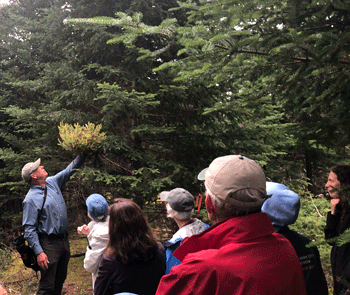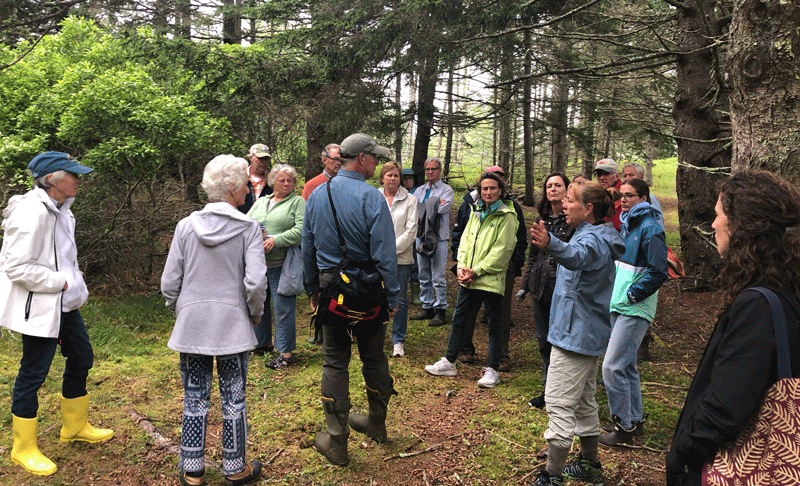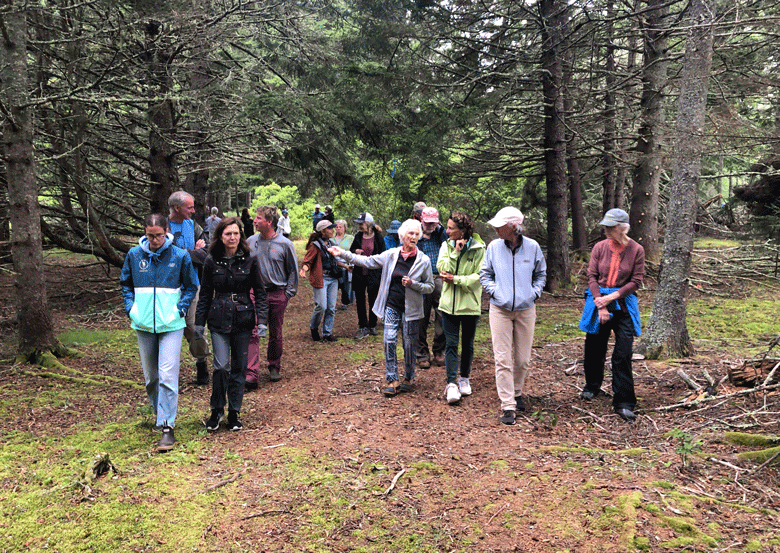To understand the heavily forested environments of North Haven and Vinalhaven, you must understand what came before. And what came before was farming.
Chuck Gadzik of Vinalhaven, who led a community walk devoted to resilient and diverse forests on the islands earlier this year, explained that when farms stopped operating, a new progression of growth began.
“A lot of the agriculture on both islands started to become abandoned in the early 1900s,” he said. What grew in those uncultivated fields was white spruce.

He explained that unused Maine island farm fields create environments in which white spruce stands take root, then collapse 80-100 years later, depending on the quality of soil.
“You can define the old agricultural footprint by the white spruce, and what you see along the fringes is the red spruce migrating back in. This is what we call advanced regeneration.”
Gadzik added that the more desirable red spruce can live 300 years, usually less on islands due to soil conditions.
Giving red spruce space to grow regenerates struggling forests, he said. Helping this tree dominate is a good idea because it is a “master of many skills,” growing very well when conditions are good, handling drought, and regenerating successfully.
He described this Acadian forest native as “patient” and a “marathon runner.” The red spruce can even be dormant for 70-80 years and then start growing again. Gadzik advised that if balsam fir is browning on its lower branches, it is going to die anyway; removing fading balsam fir will help release the red spruce, and so contribute to restoring the forest to a healthier state.
Although there is 20% more rainfall this century than in the last, he said, this increased precipitation comes in high impact storms and so does not mitigate reoccurring forest drought stress. During times of drought, trees go into a standstill with no photosynthesis, a response more troublesome on islands where soil is thinner.

“When it’s really dry, like last summer, the soil is like powder.”
Gadzik and John Stevens, executive director of North Haven Conservation Partners, also talked about how it is human nature to enjoy neat, manicured property that is aesthetically pleasing, including within forests. But wildlife thrives in more natural “messy” environments.
Stevens described how it is best to balance orderly spaces with leaving some areas more natural, while keeping in mind how the forest could become a fire hazard. For example, leaving some downed trees or cutting them up in chunks rather than chipping them provides for natural habitats, including higher quality soil, that support healthy plant and animal biodiversity.
One of the two dozen participants in the community walk, Alice Cornwell, asked Gadzik how a warming climate might affect island forests. It’s unclear how the climate might impact the red spruce given the strength of this tree, he said, adding that a more pressing concern is that a warming climate is more hospitable to invasive species which can then displace more desirable native species.
“Extreme wind events are the real threat. Last year there were six storms at 50-plus mile per hour winds. My theory is once we hit a hundred, a lot will go down,” he said.
Thinning trees then allows healthy ones to build better root systems that protect them from high winds.
Jody Bush reminded participants that forests can be restarted in small patches, so the process is not so overwhelming to property owners. For example, North Haven resident Cindy Page germinated acorns for oak saplings that are now growing well.
“I kind of spoiled them,” said Page, describing how she watered them every three days.





